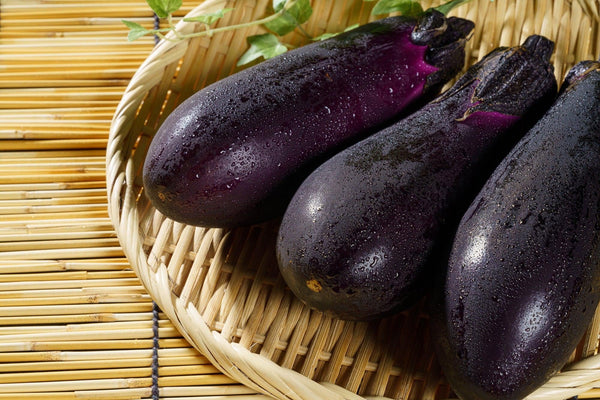
Jump to:
Japanese eggplant (used synonymously with the Japanese word “Nasu” in this blog post) is from the nightshade family, which lumps it in with things like tomatoes and bell peppers. Like these other members of the nightshade family, although commonly thought of as a vegetable because of its savory flavor, the Japanese eggplant is botanically considered a fruit.
This article will tell you everything you need to know about this oddly shaped but delicious fruit, including how it compares to other types of eggplant, how to cook Japanese eggplant, popular dishes in which it is used, and alcoholic beverages it pairs well with, as well as looking at its health benefits and even potential health risks. Anyway, let’s start by meeting the family.
Meet The Nightshade Family

Nightshade is a family of plants containing both fruits, such as tomatoes, peppers, and eggplants, and vegetables such as potatoes. There are also nightshades considered harmful to human health including the aptly named “Deadly nightshade” and tobacco. Nightshades are unique because they contain alkaloids, a class of naturally occurring nitrogen-containing compounds found in plants. More on these later!
So, nightshade is the name of the family of plants, but within this overall category, there are also different types of eggplants. Before briefly looking at these different types, it would probably be best to clear up one thing. An aubergine does not denote a different type of fruit to the eggplant. They are just different names for one and the same plant. The U.K., probably because of its proximity to the European continent, has adopted the French word “aubergine”, whereas eggplant is used virtually everywhere else in the English-speaking world. Because of the people who use the word “aubergine”, however, it has come to mean the rounder, rather fatter purple fruit enjoyed in the U.K.
Types Of Eggplants

What is distinctive about the Japanese eggplant? It has fewer seeds than some other varieties, which gives it a gentler, more delicate, and less bitter taste. (As a general rule of thumb, the more seeds contained in the fruit, the more naturally bitter it will taste). Its gentle flavor means that it matches well with bold tastes, such as garlic, chili, and ginger. Although available all year round, the peak season for Japanese eggplants is from summer to autumn.
So, what other types of eggplants are there and how do they differ? Probably the most similar one to the Japanese “nasu” eggplant, at least appearance-wise, is the Chinese eggplant. Both are purple, and longer and thinner than their European counterparts. The Japanese version tends to be smaller and with a darker color skin. Like Japanese eggplants, Chinese eggplants are virtually seedless so sweeter than many other types.
Other types of eggplant include the Sicilian variety, which is called Graffiti eggplant due to its purple and white stripes, the Italian eggplant and American globe eggplant which are both smaller, fatter, and more bitter than those found in East Asia, and white and green eggplants from India.
It is not as if there is only one type of “nasu” either. Japan contains many varieties with their own shapes and characteristics that originate locally. An example of this is “Kamonasu”, which originates in Kyoto.
Although this article will concentrate on Japanese eggplants, variety is the spice of life, and we would encourage you to go out and try as many of the different types as possible as they all have something to offer.
How Do You Prepare Japanese Eggplant?

Perhaps the best way of describing Japanese eggplants is “sturdy yet spongy”. This means that while the skin doesn’t break and fall apart easily, the inside easily absorbs the flavors of the sauces and seasonings that they are cooked in. This is why, despite being criticized by some for being tasteless, they provide both excellent flavor and texture when used in cooking.
Before looking at various ways of cooking “Nasu”, we should note that although rarely eaten raw because of their natural toughness, they are an important ingredient of Shibazuke, a form of salt-pickled vegetables (or fruit in this case) from Kyoto. This dish, in which the eggplant is often served with shiso and ginger, is particularly refreshing in the summer.
Other ways of preparing Japanese eggplant include grilling, roasting, stir-frying, deep-frying, and boiling. Let us look at some typical dishes that use this versatile fruit.
Popular Dishes Using “Nasu”
Eggplant Miso

A popular way of preparing Japanese eggplant is by stir-frying, and one dish that uses this is eggplant miso, which makes a scrumptious side dish that is an excellent buddy for white rice.
This is a simple but delicious dish that is made as follows:
- Cut the eggplant into randomly-sized pieces.
- Add oil to a large pan and saute the eggplant pieces thoroughly.
- Cook the eggplant through, add sugar, as necessary, and stir.
- Add a desired amount of aka-miso and stir-fry again.
We have a recipe for dengaku miso nasu which is a type of eggplant miso on our blog, so be sure to check it out!
Nasu no nibitashi

Another popular dish that uses Japanese eggplant is Nasu no nibitashi. The eggplant is combined with daikon (giant radish), and ginger in a noodle soup base. The dish is usually either eaten on its own or used as a topping for tofu or udon noodles.
- Chop off the head section of the eggplant, cut it into bite-size pieces, and make diagonal notches in the skin.
- Grate the daikon (giant radish)
- Put cooking oil in a pan heated over a medium flame and fry the eggplant
- Once the eggplant is cooked through, add the grated daikon, ginger, and noodle soup and heat.
- Simmer briefly, and after cooking over a low heat for about 5 minutes, remove the pan.
In addition to the above dishes, nasu is commonly enjoyed deep-fried as tempura, stir-fried with other meat and vegetables, as “Mapo nasu” a Chinese-style spicy dish with beef mince, or as “Nasu agebitashi”, in which thick deep-fried slices of eggplant are served in a shoyu (soy sauce) broth.
Pairing Nasu With Alcohol

Nasu also pairs very well with various alcoholic beverages. Fried nasu with miso and other savory flavorings, as well as the salty flavor of shibazuke, work really well as tsumami served with beer.
As mentioned before, Japanese eggplant absorbs the flavors of the food it is combined with so when cooked in Japanese-style dishes it naturally pairs well with Japanese sake, and when used to add bulk to a meat dish, it can be enjoyed with darker, full-bodied red wines, such as Cabernet Sauvignon and Shiraz.
If you're looking for some seriously delicious sake to pair your Japanese eggplant dishes with, then be sure to check here.
Is “Nasu” A Nutrition-Free Fruit?
Japanese eggplant has gotten an unfair rep, even in its native Japan, for being a nutrition-free fruit. This seems to stem from the fact that, at approximately 90%, it has a very high water content. This shouldn’t be considered a negative in terms of its health-giving properties, though. Eating eggplant in summer is known to lower your body temperature and help keep you hydrated.
Additionally, not only does “nasu” include many nutrients beneficial for your health, but, similarly to onions and artichokes, it retains a high proportion of these nutrients even when cooked. It is a very good source of dietary fiber, B vitamins, and potassium, and also contains many antioxidants, which are known to protect the body from damage caused by harmful substances known as free radicals, and thus help prevent chronic conditions, such as heart disease and cancer.
It is especially rich in an anthocyanin called nasunin. This is a photochemical that is concentrated in the purple skin of eggplants and protects it from the sun’s rays and environmental damage. Some studies have suggested that nasunin looks after cognitive function in humans by protecting brain cell membranes from free radicals and works to keep cells healthy by supplying them with nutrition and removing waste.
Having a high level of fiber, which improves satiety, and being naturally low in calories, Japanese eggplants may also help prevent obesity. The absorbent nature of eggplants means that they can soak up large amounts of oil, however, and it might be better to avoid the deep-fried method of preparation if using them as part of a weight management plan.
In any case, what should be clear from the above information is that nasu is anything but a nutrition-free fruit and that eating them can contribute to a balanced, healthy diet.
Are There Health Risks In Eating Nightshades?
Nightshades, the family to which Japanese eggplants belong, have received some bad press in recent years due to the existence of alkaloids. Alkaloids are valuable medicinal agents that can be used in the treatment of a wide variety of diseases, including malaria and diabetes.
There is a toxic variety, however, called glycoalkaloids, which, evolutionarily, are produced by nightshades to keep the creepy crawlies away and help secure the survival of the plant. The debate about nightshades, including eggplant, centers on whether these same toxins can be harmful to humans. Indeed, it has been suggested that they may exacerbate auto-immune disorders and irritable bowel syndrome. Some celebrities, such as NFL star Tom Brady, follow a diet that has nightshades removed due to the claim that this reduces inflammation.
The science suggests, however, that whereas nightshades may worsen existing inflammatory conditions, in most people they will not have any negative effects, and eggplants in particular may have an anti-inflammatory effect. So, unless you already suffer from an inflammatory condition, there seems little evidence that there are any health concerns with consuming eggplants.
Nasu – Neither Nutrition-Free Nor Bland

Although slated in some quarters as being tasteless and nutrition-free, Japanese eggplant is neither of the above. Although low in flavor when eaten alone, they draw out the flavor of the food they are paired with, and this combines with their unique texture to create a highly pleasing gastronomic experience. This also means that they pair well with a wide range of different alcoholic beverages depending on the dish in which they are used. They contain many essential nutrients and antioxidants, as well as being a stellar source of dietary fiber, which is an element often lacking in the modern diet.
What is your favorite way of eating nasu? Let us know in the comments.


0 comments